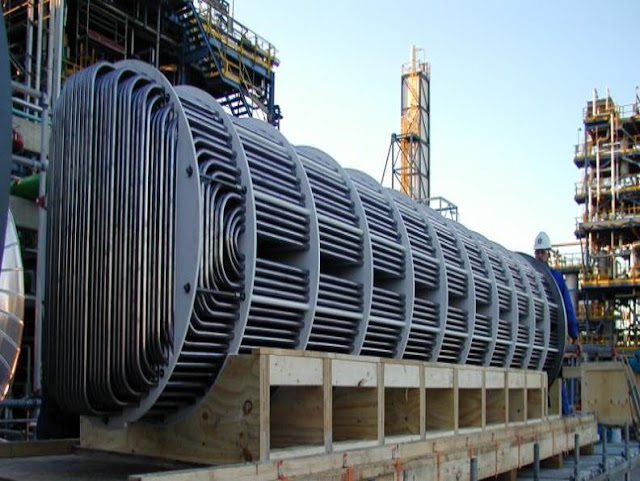Tantalum: a fantastic material for Chemical Industries. Heat Exchangers Applications.
Tantalum is the most corrosion-resistant metal in common use today. It is inert to practically all organic and inorganic compounds. Its corrosion resistance is very similar to glass, as both are unsuitable for use in hydrofluoric acid and strong hot alkali applications. For this reason, Tantalum is often used with glass-lined steel Reactors as patches, Dip Tubes, Piping and Overhead Condensers.
Tantalum is inert to sulfuric and hydrochloric acid in all concentrations below 300°F. Attack up to 400°F is not significant and Tantalum is in common use up to 500°F. Tantalum is not attacked by nitric acid in concentrations up to 98% and temperatures up to at least 212°F. Tantalum has proven itself to be totally inert in many applications. Some Heat Exchanger installations have been in continuous use for over 40 years in multi-product research environments without so much as a gasket change.

The corrosion resistance, heat transfer properties and workability of Tantalum make it a perfect construction material for a wide range of equipment and applications. Common types of Tantalum fabrication are Heat Exchangers, Condensers, Columns or Towers, Reactors, Helical Coils, Pipe Spools, Valve Linings and a variety of other components exposed to extremely corrosive fluids. Applications of Tantalum can be fabricated into most TEMA-type design Shell and Tube Heat Exchangers and Bayonet Heaters for chemical, petrochemical and pharmaceutical applications.
Applications of Tantalum should be considered wherever corrosion is a factor and long-term benefits of reduced downtime, increased life expectancy and profitability is important. For many applications, Tantalum is the only reasonable choice.
MERSEN propose two main types of Heat Exchangers as Condensers for the Pharmaceutical Industry:
- Shell & Tubes Heat Exchanger on both vertical or horizontal position.
- U-Bundle Heat Exchanger

MERSEN Tantalum Shell & Tubes Heat Exchangers are designed for condensation inside the tubes. They can be installed horizontally or vertically…
- Tubes are usually ¾” or 1”, out of Ta 2,5% Tungsten (W) for higher mechanical strength (Tensile strength almost 3 times more as Chemically pure Ta).
- Wall thickness of tube is 0,40 mm or 0,50 mm according to design pressure (for example, ¾” tube x 0,40 mm, approx. 8 bar max around the tubes, approx. 17 bars max for 0,50 mm)
- Tube Sheet are in Steel or Stainless steel and lined with Tantalum sheet (0,50 or 0,76 mm).


Tube Sheets can be designed in two different ways :
Flush Mount design : to avoid fluid retention and make cleaning easier.


Lip Welding design : as standard design.


Usually, Overhead Condensers are designed with one side Flush Mount tubes sheet, and other side Lip-Welding type.
MERSEN Tantalum U-Bundle Heat Exchangers are designed for condensation inside or outside the tubes. They are usually installed horizontally…
- Tubes are usually ½” or ¾” out of Ta 2,5% Tungsten (W) for higher mechanical strength (Tensile strength almost 3 times more as Chemically pure Ta).
- Wall thickness of tube is 0,40 mm or 0,50 mm
- Tube Sheet are in Steel or Stainless steel and lined with Tantalum sheet (0,50 or 0,76 mm).
 Baffles made out of PTFE and fixed with Tantalum Tie Rods & PTFE spacers
Baffles made out of PTFE and fixed with Tantalum Tie Rods & PTFE spacers
The Bigger ever built….MERSEN Manufacturer

310m², 490 tubes 34” x 0,40 mm, DN1100, length 5400 mm…
As far as Plate Heat Exchangers are concerned Tantalum was not common used.
Recently thanks to a unique surface treatment technology, Alfa Laval tantalum heat exchangers look to have the same high corrosion resistance as a heat exchanger made of solid tantalum.
The stainless steel core undergoes a chemical vapour deposition procedure where a thin (50 μm) layer of tantalum is built up and metallurgically bonded to the steel surface. The surface layer is 100% dense and firmly attached to the steel, even if the material is bent or dented.

For the time being Alfa Laval tantalum heat exchangers are available in three small sizes .Each size is available in versions with different plate patterns and different number of plates to suit different flow characteristics.
The relatively high initial cost of Tantalum equipment is offset by its extremely low corrosion and long life-time. Life cycle costs and manufacturing efficiencies need to be evaluated for a globally competitive manufacturing facility. Applications of Tantalum in process equipment meet all these challenges.

Therefore next time you have to design an Heat Exchanger for severe conditions start to consider Tantalum: with new geometry of small diameter tubes Shell& Tube Heat Exchanger in Tantalum could compete with Graphite and Silicon Carbide units!



Wonderful blog, Which help us to understand information easily and fast. Keep sharing more info on this ASTM A193 B8 FASTENERS Visit DC Engineering Products to more relevant services.
RispondiElimina